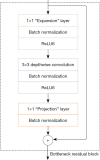Using 2-dimensional hand photographs to predict postoperative biochemical remission in acromegaly patients: a transfer learning approach
- PMID: 37284118
- PMCID: PMC10240016
- DOI: 10.21037/qims-22-1101
Using 2-dimensional hand photographs to predict postoperative biochemical remission in acromegaly patients: a transfer learning approach
Abstract
Background: The primary treatment goals in acromegaly patients are complete surgical removal of underlying pituitary tumors and biochemical remission. One of the challenges in developing countries is the difficulty in monitoring postoperative biochemical levels in acromegaly patients, particularly those who live in remote areas or regions with limited medical resources.
Methods: In an attempt to overcome the abovementioned challenges, we conducted a retrospective study and established a mobile and low-cost method to predict biochemical remission in acromegaly patients after surgery, the efficacy of which was assessed retrospectively using the China Acromegaly Patient Association (CAPA) database. A total of 368 surgical patients from the CAPA database were successfully followed up to obtain their hand photographs. Demographics, baseline clinical characteristics, pituitary tumor features, and treatment details were collated. Postoperative outcome, defined as biochemical remission at the last follow-up timepoint, was assessed. Transfer learning with a new mobile tailored neurocomputing architecture, MobileNetv2, was used to explore the identical features that could be used as predictors of long-term biochemical remission after surgery.
Results: As expected, the MobileNetv2-based transfer learning algorithm was shown to predict biochemical remission with statistical accuracies of 0.96 and 0.76 in the training cohort (n=803) and validation cohort (n=200), respectively, and the loss function value was 0.82.
Conclusions: Our findings demonstrate the potential of the MobileNetv2-based transfer learning algorithm in predicting biochemical remission for postoperative patients who are at home or live far away from a pituitary or neuroendocrinological treatment center.
Keywords: Acromegaly; MobileNetv2; biochemical remission; transfer learning.
2023 Quantitative Imaging in Medicine and Surgery. All rights reserved.
Conflict of interest statement
Conflicts of Interest: All authors have completed the ICMJE uniform disclosure form (available at https://qims.amegroups.com/article/view/10.21037/qims-22-1101/coif). SY was supported by the Guangdong Basic and Applied Basic Research Foundation (No. 2023A1515011644) and the Chinese Postdoctoral Science Foundation (No. 2019M663271). WC was supported by the Clinical Research Project of The East Division (the First Affiliated Hospital, Sun Yat-sen University, No. 2019004) and the National Natural Science Foundation of China (No. 82203179). The other authors have no conflicts of interest to declare.
Figures





Similar articles
-
Predictors of postoperative biochemical remission in acromegaly.J Neurooncol. 2021 Jan;151(2):313-324. doi: 10.1007/s11060-020-03669-4. Epub 2021 Jan 4. J Neurooncol. 2021. PMID: 33394265 Free PMC article.
-
Impact of tumor characteristics and pre- and postoperative hormone levels on hormonal remission following endoscopic transsphenoidal surgery in patients with acromegaly.Neurosurg Focus. 2020 Jun;48(6):E10. doi: 10.3171/2020.3.FOCUS2080. Neurosurg Focus. 2020. PMID: 32480366
-
Development and Interpretation of Multiple Machine Learning Models for Predicting Postoperative Delayed Remission of Acromegaly Patients During Long-Term Follow-Up.Front Endocrinol (Lausanne). 2020 Sep 16;11:643. doi: 10.3389/fendo.2020.00643. eCollection 2020. Front Endocrinol (Lausanne). 2020. PMID: 33042013 Free PMC article.
-
Evolving criteria for post-operative biochemical remission of acromegaly: can we achieve a definitive cure? An audit of surgical results on a large series and a review of the literature.Endocr Relat Cancer. 2003 Dec;10(4):611-9. doi: 10.1677/erc.0.0100611. Endocr Relat Cancer. 2003. PMID: 14713271 Review.
-
Surgical treatment of acromegaly according to the 2010 remission criteria: systematic review and meta-analysis.Acta Neurochir (Wien). 2016 Nov;158(11):2109-2121. doi: 10.1007/s00701-016-2903-4. Epub 2016 Sep 2. Acta Neurochir (Wien). 2016. PMID: 27586125
Cited by
-
Consensus on acromegaly therapeutic outcomes: an update.Nat Rev Endocrinol. 2025 Aug 13. doi: 10.1038/s41574-025-01148-2. Online ahead of print. Nat Rev Endocrinol. 2025. PMID: 40804505 Review.
References
LinkOut - more resources
Full Text Sources
Research Materials
